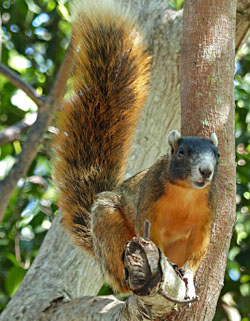CRL: Conservation Projects - Fire, Insects, & Forest Management
Differential Response of a Native Arizona Gray Squirrel and an Introduced Abert’s Squirrel to a Mosaic of Burn Severities
-
Time Period: August 2011-Present
-
Student: Shari Ketcham
-
Location: Santa Catalina Mountains, AZ, U.S.A.
-
 Major Questions: What burn severities do tree squirrels use post fire regarding resources such as dreys, cavities, and food? How large are the patch sizes of the burn severities that tree squirrels choose to use? Are there any competition factors between tree squirrels for resources post fire? If so, what resources do tree squirrels compete for? What is the estimated abundance and distribution of tree squirrels on the Santa Catalina Mountains?
Major Questions: What burn severities do tree squirrels use post fire regarding resources such as dreys, cavities, and food? How large are the patch sizes of the burn severities that tree squirrels choose to use? Are there any competition factors between tree squirrels for resources post fire? If so, what resources do tree squirrels compete for? What is the estimated abundance and distribution of tree squirrels on the Santa Catalina Mountains?

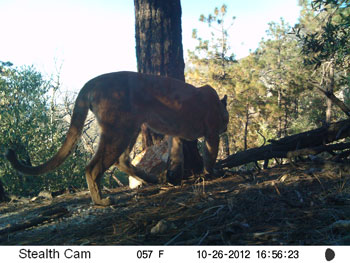
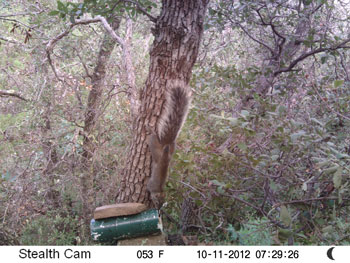
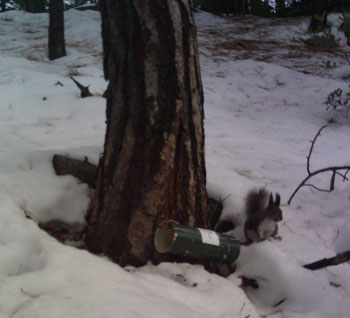
-
Major Findings: NA-Research in Progress
Project Details (click to expand/reduce)
Occurrence and habitat use by Big Cypress fox squirrels on public lands
-
Time Period:August 2016 - May 2021
-
PhD student: Kira Hefty
-
Location: Southwest Florida, U.S.A.
Project Details (click to expand/reduce)
Project Description & Bio:
 In Florida, native wildlife species face multiple threats including human development, habitat fragmentation, fire suppression, invasive species, and changes in the hydrologic regime. One of the greatest challenges to conserving species in this unique environment is a general lack of knowledge of species-specific habitat requirements and movement behavior. Big Cypress fox squirrels (Sciurus niger avicennia) are an endemic subspecies of fox squirrel in southwest Florida. Because so little is currently known about its extent of occurrence and landscape-level habitat requirements, S. n. avicennia has been declined listing as a federally protected species. Most studies involving this charismatic subspecies have been conducted in urban environments rather than in their natural habitat. In 2012, Big Cypress fox squirrels were named as a Species of Greatest Conservation Concern in Florida’s Wildlife Legacy Initiative Wildlife Action Plan. Kira will be working on public lands with multiple federal and state agencies to decrease knowledge gaps concerning this unique subspecies and provide science-based conservation and management recommendations. Kira is also interested in connecting with community members and establishing long-term outreach programs that will facilitate local interest in conserving Florida’s delicate and special ecosystems.
In Florida, native wildlife species face multiple threats including human development, habitat fragmentation, fire suppression, invasive species, and changes in the hydrologic regime. One of the greatest challenges to conserving species in this unique environment is a general lack of knowledge of species-specific habitat requirements and movement behavior. Big Cypress fox squirrels (Sciurus niger avicennia) are an endemic subspecies of fox squirrel in southwest Florida. Because so little is currently known about its extent of occurrence and landscape-level habitat requirements, S. n. avicennia has been declined listing as a federally protected species. Most studies involving this charismatic subspecies have been conducted in urban environments rather than in their natural habitat. In 2012, Big Cypress fox squirrels were named as a Species of Greatest Conservation Concern in Florida’s Wildlife Legacy Initiative Wildlife Action Plan. Kira will be working on public lands with multiple federal and state agencies to decrease knowledge gaps concerning this unique subspecies and provide science-based conservation and management recommendations. Kira is also interested in connecting with community members and establishing long-term outreach programs that will facilitate local interest in conserving Florida’s delicate and special ecosystems.
Research Questions:
1) What is the extent of occurrence of S. n. avicennia? 2) Which habitat features are associated with S. n. avicennia presence? 3) How has habitat degradation and fragmentation affected S. n. avicennia dispersal and movement patterns?
Big cypress fox squirrel - photo courtesy of John Kellam
If you build it will they come? Artificial midden creation and settlement by Mt. Graham red squirrels
Time Period: January 2017 - May 2019
-
PhD student:Marina Morandini
-
Location: Pinaleño Mountains, Arizona, U.S.A.
-
Project Description & Bio:
-
 I am interested in which factors can regulate or limit population abundance. No population increases without limit, but understanding the factors that prevent this phenomenon is not easy. There are intrinsic and extrinsic factors that influence population size. Extrinsic factors influence populations by actions of other species, such as predators or competitors, and by physical-chemical factors such as climate or nutrient supplies. Intrinsic factors instead are internal to the population, such as sex, age, behavior and genetic traits. Understanding which factors could affect population dynamics of a particular animal or plant is the core of conservation, land management, fisheries and pest control and are crucial to developing specific management plans for individual species.
I am interested in which factors can regulate or limit population abundance. No population increases without limit, but understanding the factors that prevent this phenomenon is not easy. There are intrinsic and extrinsic factors that influence population size. Extrinsic factors influence populations by actions of other species, such as predators or competitors, and by physical-chemical factors such as climate or nutrient supplies. Intrinsic factors instead are internal to the population, such as sex, age, behavior and genetic traits. Understanding which factors could affect population dynamics of a particular animal or plant is the core of conservation, land management, fisheries and pest control and are crucial to developing specific management plans for individual species.
-
Research questions:
Despite more than fifteen years of legal protection, Mt Graham Red Squirrel population plummeted after a peak of 562 squirrels in 1999 to approximately 250 individuals in the recent years. Why is the population abundance not increasing? Are food resources a limited factor for this population? Can artificial midden help the settlement of squirrels during dispersal? Is there a high predator pressure on the squirrel population on Mt. Graham? Is it possible that parasites play a role in the regulation of this population? -
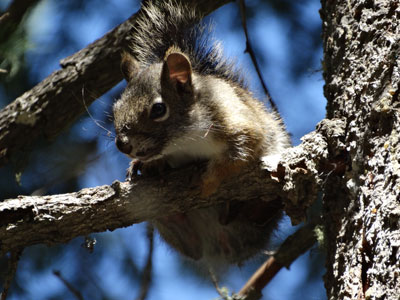
Personal background:
I completed my master’s degree in Italy where I studied the competition between the European Red Squirrel (Sciurus vulgaris) and the invasive species Pallas’s squirrels (Callosciurus erythraeus), whose native range is in southeast Asia. In particular I analyzed the competition for food and space, using telemetry and live-trapping.
I worked The University of Milan to control the invasive population of the Grey Squirrel near Milan.I volunteered for six months for Kluane Red Squirrel project (Yukon, Canada) where I worked to collect data on populations dynamics of red squirrel and snowshoe hare.
Project Details (click to expand/reduce)
Can red squirrel middens influence species diversity?
-
Time Period: August 2010-Present
-
Student: Erin Posthumus
-
Location: Mt. Graham, AZ, U.S.A.
-
 Red squirrels create structures, called middens, that concentrate food resources and create structural complexity in the forest, and some studies have found certain wildlife species to be associated with these middens. What is unclear is which characteristics of these middens attract species. My research will attempt to show which midden characteristics are most valuable to species diversity, which will have implications for forest management practices. My study will also shed light on the importance of larderhoarding animals to species diversity.
Red squirrels create structures, called middens, that concentrate food resources and create structural complexity in the forest, and some studies have found certain wildlife species to be associated with these middens. What is unclear is which characteristics of these middens attract species. My research will attempt to show which midden characteristics are most valuable to species diversity, which will have implications for forest management practices. My study will also shed light on the importance of larderhoarding animals to species diversity. -
Major Questions: Does species diversity differ at occupied middens, unoccupied middens and random locations? What characteristics of middens (i.e. vegetation features, food resources, and midden structure) affect species diversity? What is the importance of midden microclimate in explaining diversity?
-
Major Findings: Research in Progress
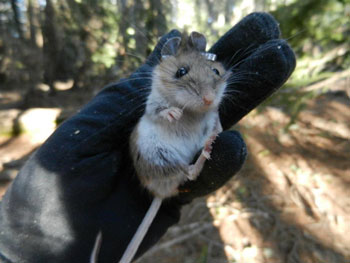
Project Details (click to expand/reduce)
Competition between native and introduced species
-
Time period: August 2010 – present
-
Student: Jonathan J. Derbridge
-
Location: Pinaleño Mountains, Arizona, USA
-
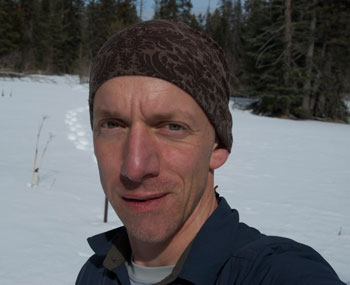 Major Questions: I am studying mechanisms of competition between native and introduced species. Exploitation competition occurs when individuals have indirect negative effects on other individuals by restricting access to a common resource. Competition from introduced species for common food resources may force native species to forage more widely, and consume sub-optimal diets. Isolated populations of territorial species may, over time, become less adept at excluding ecologically similar competitors. I am using experimental removals of introduced Abert’s squirrels (Sciurus aberti) to test hypotheses on the impacts of dietary and spatial overlap with the Mount Graham red squirrel (Tamiasciurus hudsonicus grahamensis). I am also conducting tests of exploitation competition that relate to the relative abilities of an invader to succeed, and a native species to maintain its advantage. These tests include examining how Abert’s squirrels may take advantage of larder-hoarding by red squirrels, and comparing territorial behavior of Mount Graham red squirrels with individuals in other red squirrel populations.
Major Questions: I am studying mechanisms of competition between native and introduced species. Exploitation competition occurs when individuals have indirect negative effects on other individuals by restricting access to a common resource. Competition from introduced species for common food resources may force native species to forage more widely, and consume sub-optimal diets. Isolated populations of territorial species may, over time, become less adept at excluding ecologically similar competitors. I am using experimental removals of introduced Abert’s squirrels (Sciurus aberti) to test hypotheses on the impacts of dietary and spatial overlap with the Mount Graham red squirrel (Tamiasciurus hudsonicus grahamensis). I am also conducting tests of exploitation competition that relate to the relative abilities of an invader to succeed, and a native species to maintain its advantage. These tests include examining how Abert’s squirrels may take advantage of larder-hoarding by red squirrels, and comparing territorial behavior of Mount Graham red squirrels with individuals in other red squirrel populations. 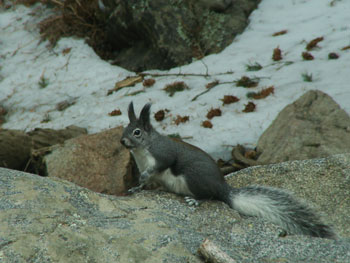
-
Research Questions: What are the impacts of dietary overlap between native and introduced species occupying similar niches? Does syntopy with an introduced species incur fitness costs associated with changes in home range size and composition for native species? Do introduced non-hoarding species compete with larder-hoarding native species through kleptoparasitism? Does isolation from interspecific competition lead to weakening of territorial behavior and facilitate successful invasions?
Project Details (click to expand/reduce)
Proximate cues and ultimate consequences for natal dispersal and settlement in an altered forest landscape: influence of experience, behavior, and habitat
-
Time Period: May 2010 - Present
-
Student: Melissa Merrick
-
Location: The Pinaleño Mountains, AZ, U.S.A.
-
 Major Questions: I am interested in factors influencing animal movements and habitat selection in the face of landscape alteration and fragmentation. Movement via natal dispersal is an important ecological mechanism contributing to gene flow, population structure and population dynamics, and guards populations against local extinction. Natal dispersal includes three stages: emigration, transience and exploration, and immigration and settlement. Whether an individual disperses, if it disperses how far it travels, how many places it explores, and where it settles is highly variable and is conditioned upon many factors including individual condition, local population density, sex ratios, resource abundance, experience in the natal area, habitat fragmentation, and individual behavior differences. Previous studies have shown that experience in the natal area provides individuals with important habitat cues which aid in deciding upon where to settle and also leads to variation in settlement patterns. Individual behavior differences may play a role in
Major Questions: I am interested in factors influencing animal movements and habitat selection in the face of landscape alteration and fragmentation. Movement via natal dispersal is an important ecological mechanism contributing to gene flow, population structure and population dynamics, and guards populations against local extinction. Natal dispersal includes three stages: emigration, transience and exploration, and immigration and settlement. Whether an individual disperses, if it disperses how far it travels, how many places it explores, and where it settles is highly variable and is conditioned upon many factors including individual condition, local population density, sex ratios, resource abundance, experience in the natal area, habitat fragmentation, and individual behavior differences. Previous studies have shown that experience in the natal area provides individuals with important habitat cues which aid in deciding upon where to settle and also leads to variation in settlement patterns. Individual behavior differences may play a role in dispersal distance and settlement decisions, including decision rules individuals employ when selecting a place to settle. Local density of conspecifics and associated sex ratios may influence male settlement decisions, whereas female settlement decisions may be more driven by available food resources. Increasingly, habitat fragmentation is also becoming an external factor influencing dispersal decisions and evidence suggests that small mammals dispersing through a fragmented habitat matrix tend to disperse further and explore less than individuals in contiguous habitat. I am testing several hypotheses related to natal habitat preference induction, behavioral phenotypes, decision rules, and habitat fragmentation and their influence on natal dispersal, especially transience and immigration.
dispersal distance and settlement decisions, including decision rules individuals employ when selecting a place to settle. Local density of conspecifics and associated sex ratios may influence male settlement decisions, whereas female settlement decisions may be more driven by available food resources. Increasingly, habitat fragmentation is also becoming an external factor influencing dispersal decisions and evidence suggests that small mammals dispersing through a fragmented habitat matrix tend to disperse further and explore less than individuals in contiguous habitat. I am testing several hypotheses related to natal habitat preference induction, behavioral phenotypes, decision rules, and habitat fragmentation and their influence on natal dispersal, especially transience and immigration. -
Some of my main research questions include: Do natal habitat cues (e.g. habitat structure, associated microclimate, and food availability) influence where settlement occurs? Do individual behavior differences (behavioral phenotypes) influence exploratory movements, decision rules, dispersal distance, and survival? Does forest fragmentation influence decision rules, settlement choices, and survivorship?
-
Major Findings To Date: Compared to non-peripheral red squirrel populations, dispersal in MGRS is sex-biased and exploration movements and settlement distances are far greater. Individual behavior differences explain variation in dispersal distances - active, aggressive individuals tend to disperse longer distances compared to less active, docile individuals. Natal habitat structure may play a role in cueing dispersers in on locations in which to settle. Forest structure derived from remotely sensed LiDAR data (e.g. canopy cover, basal area of live trees) in an individual’s natal area is more similar to forest structure at an individual’s settlement location compared to random locations. Further analyses are underway.

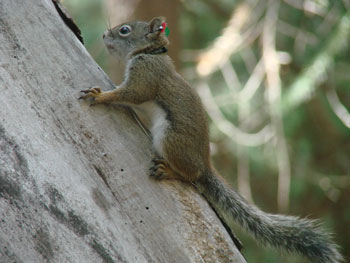
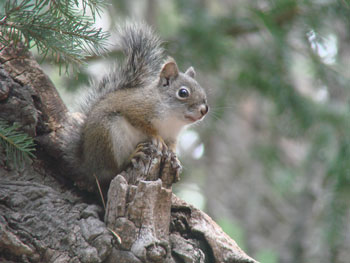
Project Details (click to expand/reduce)
Ecology of Neotropical Tree Squirrels
-
Time Period: May – July 2009 and June – July 2010
-
Student: Rosa Jessen
-
Location: Area de Conservacion Regional Tamshiyacu-Tahuayo, Loreto, Peru
-
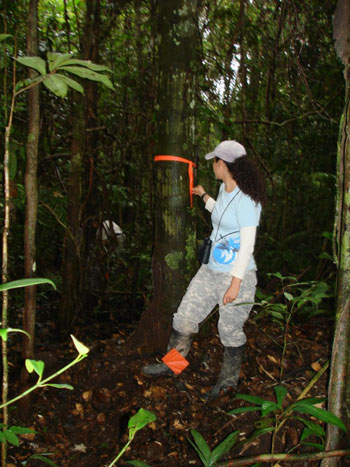 Major Questions: Does vegetation type affect density and habitat use of neotropical tree squirrels? What vegetation characteristics are influential to rainforest squirrels? What is the mammalian diversity associated with neotropical tree squirrels?
Major Questions: Does vegetation type affect density and habitat use of neotropical tree squirrels? What vegetation characteristics are influential to rainforest squirrels? What is the mammalian diversity associated with neotropical tree squirrels? -
Rainforests are home to the greatest mammal diversity, but little is known about most of the rainforest species. Small mammals in the rainforest play important roles, providing ecological services such as seed dispersal and pollination. These species also drive the dynamics and complexity of biological communities by serving as predators and providing a prey base for a range of rainforest species. The Amazon Basin contains one of the world’s largest rainforests, much of which is found in Peru. Five species of tree squirrels are found in the Peruvian Amazon: northern Amazon red squirrel (Sciurus igniventris), southern Amazon red squirrel (S. spadiceus), Bolivian squirrel (S. ignitus), Amazon dwarf squirrel (Microsciurus flaviventer) and neotropical pygmy squirrel (Sciurillus pusillus) but there is a great lack of knowledge of neotropical tree squirrels and no one has examined their role in rainforests. Little is known about life history, ecological interactions, and distribution of these squirrels.
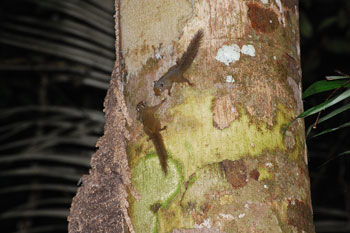
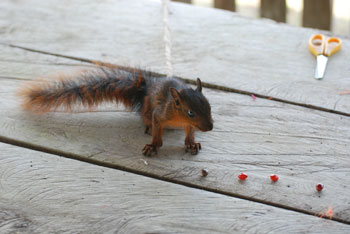
Project Details (click to expand/reduce)
Factors influencing habitat use by wildlife relative to landscape disturbance
-
Time Period: August, 2006 – December, 2010
-
Student: Sandy Doumas
-
Location: The Chiricahua Mountains, AZ, U.S.A.
-
 Major Questions: I am interested in factors influencing habitat use by wildlife relative to landscape disturbance, especially fire. Fire is a necessary and recurring disturbance in many ecosystems with profound effects over time on vegetation composition, structure, and landscape pattern. The effects of fire on ecosystems have been complicated by decades of fire suppression followed by reintroduction of fire into fire-deprived ecosystems. Historically, fire-adapted forests were relatively resilient to fire, and some current forest management techniques seek to restore forests to historical composition, structure, and landscape pattern to recreate fire-resiliency. I study habitat use by native wildlife to better understand the response of wildlife to alterations of vegetation structure and pattern following the reintroduction of fire. Specifically, I study habitat use of the Mexican fox squirrel, Sciurus nayaritensis chiricahuae, in conifer forests of the Chiricahua Mountains of SE Arizona, which have experienced several recent fires.
Major Questions: I am interested in factors influencing habitat use by wildlife relative to landscape disturbance, especially fire. Fire is a necessary and recurring disturbance in many ecosystems with profound effects over time on vegetation composition, structure, and landscape pattern. The effects of fire on ecosystems have been complicated by decades of fire suppression followed by reintroduction of fire into fire-deprived ecosystems. Historically, fire-adapted forests were relatively resilient to fire, and some current forest management techniques seek to restore forests to historical composition, structure, and landscape pattern to recreate fire-resiliency. I study habitat use by native wildlife to better understand the response of wildlife to alterations of vegetation structure and pattern following the reintroduction of fire. Specifically, I study habitat use of the Mexican fox squirrel, Sciurus nayaritensis chiricahuae, in conifer forests of the Chiricahua Mountains of SE Arizona, which have experienced several recent fires. 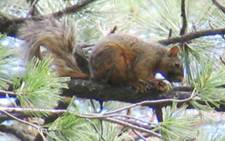
-
Some of my main research questions include: Does burn severity of recent fires and vegetation structure affect squirrel habitat use? How are the vegetation characteristics most important to habitat use related to burn severity? Does the landscape pattern (patchiness) of burn severity affect squirrel habitat use?
-
Major Findings: To Date: Mexican fox squirrels feed in forest with open understory and closed canopy cover. Vegetation within home ranges of squirrels is characterized by lower understory density, consistent with the effects of low-severity fire, and larger trees than random locations. These results suggest that return of low-severity fire can help restore habitat for Mexican fox squirrels and other native wildlife species with similar habitat affiliations in forests with a historical regime of frequent, low-severity fire. Habitat use by Mexican fox squirrels is positively associated with moderate burn heterogeneity, suggesting that small areas of severe burn incorporated within low-severity burn may be beneficial to Mexican fox squirrels and other native wildlife species.
Project Details (click to expand/reduce)
Response of the Mount Graham Red Squirrel (Tamiasciurus hudsonicus grahamensis) to Postfire Conditions
-
Time Period: 2006-2007 (field work) 2008-2012 (data analysis, writing, publication)
-
Student: Seafha Tuttle (Blount)
-
Location:Mt. Graham, AZ, U.S.A.
-
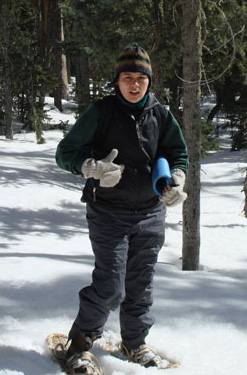 Major Questions/Objectives: Our main objectives were to assess space use of Mount Graham red squirrels, vegetation characteristics associated with middens, and continued occupancy of middens, mountain-wide, by Mount Graham red squirrels in areas of various burn severity.
Major Questions/Objectives: Our main objectives were to assess space use of Mount Graham red squirrels, vegetation characteristics associated with middens, and continued occupancy of middens, mountain-wide, by Mount Graham red squirrels in areas of various burn severity. -
Major Findings: A main effect of season on both size of home ranges and core areas was apparent. No main effect of burn severity on size of home range or size of core area was detected. Slope, canopy cover, burn severity, and aspect were important variables for distinguishing middens from random locations. Dead trees, aspect, and total number of trees were important for distinguishing between occupied and unoccupied middens. Mountainwide, occupancy of middens was influenced by burn severity of middens and surrounding vegetation. Also, unburned middens were occupied more continuously than burned middens.

-
Citation: Blount and Koprowski. 2012. Response of the Mount Graham red squirrel (Tamiasciurus hudsonicus grahamensis) to postfire conditions. The Southwestern Naturalist 57(1):8-15
Project Details (click to expand/reduce)
Ecology of the endemic Mearns’s squirrel (Tamiasciurus mearnsi) in Baja California, Mexico
-
Time Period: August 2004 – May 2008
-
Students: Nicolas Ramos-Lara
-
Location: Sierra de San Pedro Mártir, Baja California, Mexico
-
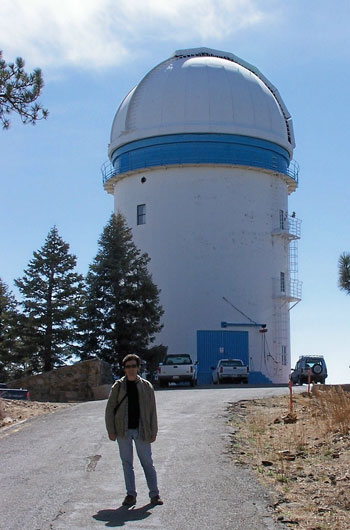 Major Questions: 1. What is the current situation of the arboreal squirrels of Mexico (review chapter)
2. Do Mearns’s squirrels have specific habitat requirements for nesting?
3. Do home-range dynamics and habitat use of Mearns’s squirrels differ from other congeners?
4. Do life-history and behavioral tactics of Mearns’s squirrels differ from other congeners?
Major Questions: 1. What is the current situation of the arboreal squirrels of Mexico (review chapter)
2. Do Mearns’s squirrels have specific habitat requirements for nesting?
3. Do home-range dynamics and habitat use of Mearns’s squirrels differ from other congeners?
4. Do life-history and behavioral tactics of Mearns’s squirrels differ from other congeners? -
Major Findings: 1. In Mexico, there are 14 recognized species of arboreal squirrels of which four are endemic, with the states of Chiapas and San Luis Potosi possessing the greatest diversity. 2. Presently, all species are listed under some category of risk by IUCN, seven by Mexico’s SEMARNAT, and only one by CITES. 3. Our literature survey yielded 37 publications revealing that a dearth of scientific information still exists on the arboreal squirrels of Mexico. 4. States with a greater diversity of arboreal squirrels also have higher annual wood productions, which may pose a serious threat to their persistence. 5. Mearns’s squirrels rely primarily on tree cavities for nests, with nest tree species, nest tree condition, nest tree size (DBH), canopy cover, and occurrence of white firs (Abies concolor) as important characteristics of the habitat for nesting. 6. Without larderhoards (middens), home-range dynamics of Mearns’s squirrels are similar to nonterritorial squirrels of the genus Sciurus, suggesting that middens played an important role in the evolution of territoriality in Tamiasciurus. 7. Using satellite imagery, I found that remote areas in the Sierra de San Pedro Mártir appear to have suitable habitat for the species. 8. Survival of adult Mearns’s squirrels was influenced by sex and body mass. 9. Mearns’s squirrels are heavier and apparently also larger than other congeners, possibly in part as an adaptation to feed on large pine cones (Pinus). 10. Interyear variation in weather and food supply strongly influenced fitness-related traits and behavior of Mearns’s squirrels.
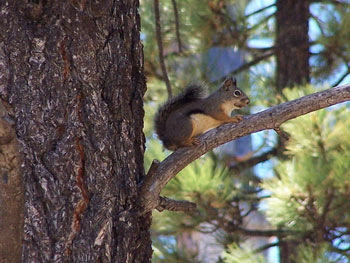
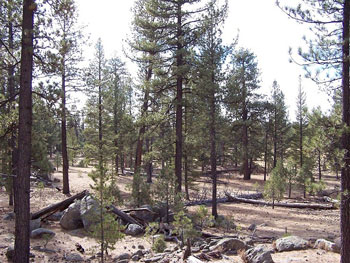

Project Details (click to expand/reduce)
Differential response to fire by an exotic and an endemic species complicate endangered species conservation
-
Time Period: May 2006 to Oct 2007
-
Student: Nate Gwinn
-
Location: Mount Graham (Pinaleño Mountains), Graham County, Arizona, USA
-
 Major Questions: The Nuttall Complex fire burned ~ 12029 ha in the Pinaleño Mountains of southeastern Arizona in summer 2004, including large areas of the upper elevation mixed conifer and spruce fir forests. Historically, mixed conifer forests in the Pinaleños experienced a low severity fire every 4 to 6 years, and spruce-fir forests experienced infrequent stand-replacement burns every 300 years. To investigate the effect of wildfire on exotic and introduced species, we looked at the differential use of burned and unburned areas by introduced Abert’s squirrels and the endemic and critically endangered Mount Graham red squirrel in the Pinaleños. We assessed effects of wildfire on habitat use of introduced Abert’s squirrels and native red squirrels by sampling species-specific feeding sign and employing radiotelemetry to reveal use of burned and unburned areas by both species. We document differential use of fire-impacted habitats that favors the introduced species thus complicating traditional conservation efforts used in forested environments.
Major Questions: The Nuttall Complex fire burned ~ 12029 ha in the Pinaleño Mountains of southeastern Arizona in summer 2004, including large areas of the upper elevation mixed conifer and spruce fir forests. Historically, mixed conifer forests in the Pinaleños experienced a low severity fire every 4 to 6 years, and spruce-fir forests experienced infrequent stand-replacement burns every 300 years. To investigate the effect of wildfire on exotic and introduced species, we looked at the differential use of burned and unburned areas by introduced Abert’s squirrels and the endemic and critically endangered Mount Graham red squirrel in the Pinaleños. We assessed effects of wildfire on habitat use of introduced Abert’s squirrels and native red squirrels by sampling species-specific feeding sign and employing radiotelemetry to reveal use of burned and unburned areas by both species. We document differential use of fire-impacted habitats that favors the introduced species thus complicating traditional conservation efforts used in forested environments. -
Major Findings: Our study is the first to document the positive response of an exotic mammal and negative response of the native species to wildfire and suggests that fire must be used judiciously as a restoration tool. Abert’s squirrels thrive in mixed conifer forest, our study documented that Abert’s squirrels fed, moved and nested within mixed conifer forest affected by wildfire. Home ranges of Abert’s squirrels were smaller in burned than in unburned forest. This suggests that habitat created by wildfire was of higher quality than unburned areas. Abert’s squirrels selected sites that had more live trees, less logs, and higher canopy closure than random sites within the burned area, similar to characteristics of mature ponderosa pine forests that Abert’s squirrels prefer in native range. These characteristics include high basal area, mature trees with interlocking crowns, and an understory with little down and woody debris. Transect data on feeding sign also indicated that Abert’s squirrels remained in burned areas. In effect, wildfire may be improving habitat for Abert’s squirrels in mixed conifer forest by creating preferred structure.
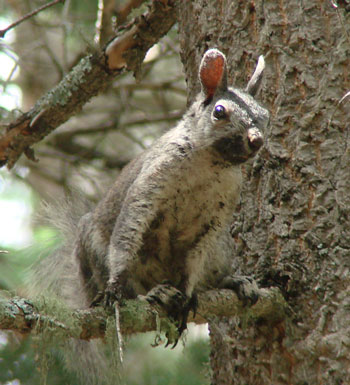
Project Details (click to expand/reduce)

Response of endangered Mt. Graham red squirrels to severe insect infestation
-
Time Period - August 2003 - April 2007
-
Student: Claire A. Zugmeyer
-
Location: The Pinaleño Mountains, AZ, U.S.A.
-
 Major Questions: Disturbance events create temporal and spatial heterogeneity of resources that can cause short- and long-term changes to habitat and disrupt interactions between individuals and resources. Severe disturbance may dramatically alter habitat structure, causing reduced reproductive success or site abandonment. Rates and impacts of natural disturbances are predicted to increase with current trends in climate change, thus highlighting the need to understand species' response to disturbance. My research examined the response of the endangered Mt. Graham red squirrel to severe insect infestation. The Mt. Graham red squirrel (Tamiasciurus hudsonicus grahamensis) occupies high elevation spruce-fir and mixed-conifer forests of the Pinaleño Mountains in southeastern Arizona. Recent recolonization of insect-damaged forest provided an opportunity to examine response of red squirrels to insect infestation. I examined habitat selection, home range, body mass, and demography of Mt. Graham red squirrels inhabiting insect-damaged forest and drew comparisons to squirrels living in relatively undamaged forest.
Major Questions: Disturbance events create temporal and spatial heterogeneity of resources that can cause short- and long-term changes to habitat and disrupt interactions between individuals and resources. Severe disturbance may dramatically alter habitat structure, causing reduced reproductive success or site abandonment. Rates and impacts of natural disturbances are predicted to increase with current trends in climate change, thus highlighting the need to understand species' response to disturbance. My research examined the response of the endangered Mt. Graham red squirrel to severe insect infestation. The Mt. Graham red squirrel (Tamiasciurus hudsonicus grahamensis) occupies high elevation spruce-fir and mixed-conifer forests of the Pinaleño Mountains in southeastern Arizona. Recent recolonization of insect-damaged forest provided an opportunity to examine response of red squirrels to insect infestation. I examined habitat selection, home range, body mass, and demography of Mt. Graham red squirrels inhabiting insect-damaged forest and drew comparisons to squirrels living in relatively undamaged forest. 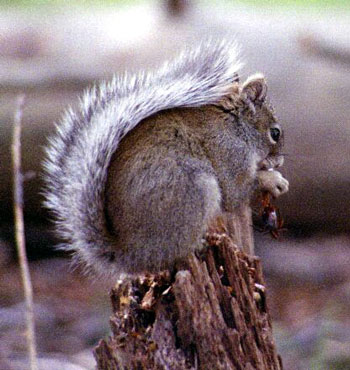
-
Major Findings: I examined habitat selection within insect-damaged forests by comparing physical and vegetative characteristics at 1) occupied middens, 2) a random subset of unoccupied historical middens, and 3) random locations. Mt. Graham red squirrels established middens in areas with <64% tree mortality. Greater basal area, canopy cover, and log volume best distinguished middens from random locations. Only greater basal area of live trees significantly distinguished occupied middens from unoccupied middens. Midden surface temperature depended on surrounding vegetation structure and tended to be cooler at occupied middens than unoccupied middens. These habitat components are congruent with features found at middens prior to the insect infestation as well as those found in other parts of the red squirrel distribution, indicating that red squirrels do not alter habitat selection after insect disturbance. I used radiotelemetric techniques and live-trapping to examine home range, body mass, and demographics of Mt. Graham red squirrels inhabiting insect-damaged and healthy forest. Squirrels living within insect-damaged forest had larger home ranges than squirrels within healthy forest. Females had larger home ranges than males in healthy forest, but I detected no difference between sexes in insect-damaged forest. Squirrel body mass, reproductive condition, and litter size did not differ between forest types, suggesting insect-damaged forest provided adequate resources. However, squirrels inhabiting insect-damaged forest experienced lower survivorship and 50% fewer potential reproductive events than squirrels in healthy forest. Although Mt. Graham red squirrels demonstrate equal-preference for habitat within insect-damaged forests and reproduce as well as individuals in healthy forest, poor survivorship and reduced potential to reproduce suggest insect-damaged forest may function as an ecological trap and has potential to threaten the persistence of this isolated population. Therefore, preservation of remaining healthy forest is a priority for management of this endangered species.
Project Details (click to expand/reduce)
Variation among red squirrel populations: Ecological differences at the edge of their range and response to fire.
-
Time Period: 2004 - 2006
-
Student: Katharine M. Leonard
-
Location: Pinaleño (Graham) Mountains, Graham County, southeastern Arizona (Coronado National Forest). White Mountains, Greenlee County, east-central Arizona (Apache-Sitgreaves National Forest).
-
Major Questions/Objectives: Populations at the edge of their geographic range may inhabit areas with different habitat structure and resources than central populations, and thus may differ in population dynamics. Understanding these unique characteristics is especially important for populations of high conservation priority, such as the endangered Mt. Graham red squirrel (Tamiasciurus hudsonicus grahamensis). The Mt. Graham red squirrel (MGRS) is endemic to southeastern Arizona, represents the southernmost red squirrel population and is found at lower densities than conspecifics in the center of the range. To determine if differences are due to conditions at the southern periphery of the range, we compared habitat characteristics, demography, body mass, space use and nesting behavior with another subspecies located at the southern edge of the range, the Mogollon red squirrel (T. h. mogollonensis). In addition, we studied demography and behavior of MGRS inhabiting areas within and outside areas of low-intensity burn following the Nuttall fire complex in the Pinaleño Mountains (summer 2004).
-
Major Findings: We found that mean and minimum daily temperatures were higher at Mt. Graham whereas maximum temperatures were higher in the White Mountains, male Mogollon red squirrels were heavier than male Mt. Graham red squirrels in all seasons and female Mogollon red squirrels were slightly heavier than female Mt. Graham red squirrels in spring, proportion of squirrels in reproductive condition was lower in female Mogollon red squirrels, Mogollon red squirrels had smaller home ranges, used different types of nests and traveled less distance to nest than Mt. Graham red squirrels. There were no differences in annual rainfall, seedfall, habitat characteristics or survival between mountain ranges. Localized conditions appear to account for the disparity between populations. These differences demonstrate the importance of evaluating attributes of peripheral populations for maximizing persistence and intraspecific diversity.
-
Upon examining MGRS physical and behavioral traits between areas of no burn and low-intensity burn from the 2004 Nuttall fire, we found that body mass, proportion of individuals in reproductive condition, and distance squirrels traveled to nest did not differ between squirrels within and outside the perimeter of the fire. Within the perimeter, red squirrels had smaller home ranges and shifted territories less frequently and had shorter distances from their previously held territories than squirrels outside the perimeter. Mount Graham red squirrels evolved with patchy, low-intensity fires like those that burned in mixed-conifer forests in the Pinaleño Mountains and may be able to persist in areas affected by this level of disturbance.
Project Details (click to expand/reduce)
Forest disturbance and the long term population persistence of the Mt. Graham red squirrel: a spatially explicit modeling approach
-
Time Period: 2002 - 2006
-
Student: David Wood
-
Location: Pinaleño (Graham) Mountains, Graham County, southeastern Arizona. (Coronado National Forest), U.S.A.
-
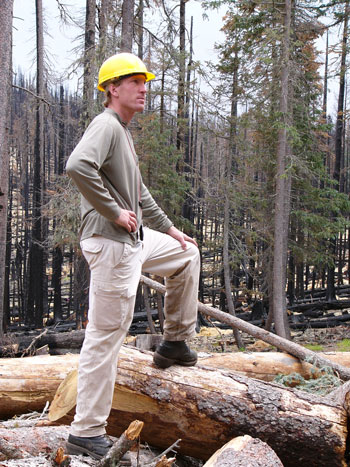 Major Questions: Difficulties in conservation and management of forest ecosystems arise from dynamics of forests and challenges in understanding disturbance. Disturbances, especially fire and insect outbreaks, have increased in occurrence and severity due to climate change and forest management.
Major Questions: Difficulties in conservation and management of forest ecosystems arise from dynamics of forests and challenges in understanding disturbance. Disturbances, especially fire and insect outbreaks, have increased in occurrence and severity due to climate change and forest management.
The Pinaleño Mountains of southeastern Arizona, USA have suffered catastrophic fire and large scale insect outbreaks in the last decade and are the only home of the federally endangered Mt. Graham red squirrel (MGRS: Tamiasciurus hudsonicus grahamensis), therefore an understanding the impacts of forest disturbances on population dynamics is critical for conservation of this fragile species. We sought to develop and a spatially explicit population model to predict long-term population dynamics of MGRS and to combine this model with life-history data and high-resolution satellite imagery with the goal of examining effects of future disturbances on the population. -
Major Findings: We tested model predictions using available range-wide red squirrel life-history data from the literature and fieldwork specific to the MGRS. An input data set using general mean life history values overpredicted MGRS abundance. However, we found significant correlation with known squirrel abundance using a general data set with curtailed fecundity and survival. A model with MGRS-specific data provided the best fit to observed population size. We investigated potential impacts of two major threats to the MGRS: competition from introduced Abert’s squirrels (Sciurus aberti) and increased levels of predation. Predation and particularly competition could have significant effects on the future population of the MGRS. Careful attention must be used to model the viability of fringe populations as peripheral populations can have a different life history than populations found in the range core. -
We also modeled potential Mt. Graham red squirrel habitat by identifying characteristics of cover surrounding their centrally defended larderhoards to assess effects of forest disturbance on habitat. We classified high spatial resolution satellite imagery into ground cover classes and used logistic regression to determine areas used by squirrels. We also used midden locations in conjunction with slope, elevation, and aspect variables to create a predictive habitat map for Mt. Graham red squirrels. Squirrels selected areas of denser forest with higher seedfall for midden sites. Among active middens, those in the densest and least damaged forests were occupied in more seasons than those in more fragmented and damaged areas. The future conservation of red squirrels and the return of healthy old-growth forests to the Pinaleño Mountains will rely on management in mixed conifer zones of the mountain and active restoration of highly damaged upper elevation spruce-fir forests to return them to squirrel habitat. This model allows us to evaluate the spectrum of fine- to coarse-scale disturbance effects (individual tree mortality to the area wide boundaries of a disturbance) with high-resolution satellite imagery.
-
Lastly, we combined our spatially explicit population model with the spatial models of habitat heterogeneity. We parameterized the model with estimates of extent, frequency, and severity of insect outbreaks and fire and used the number of Mt. Graham red squirrel populations dropping below critical population thresholds to characterize the effects of these disturbances. We determined future disturbances, even at low levels, are likely to have a detrimental effect on Mt. Graham red squirrel population size. This model framework can be used to predict effects of future disturbance on habitat quality and population persistence for species in general.
